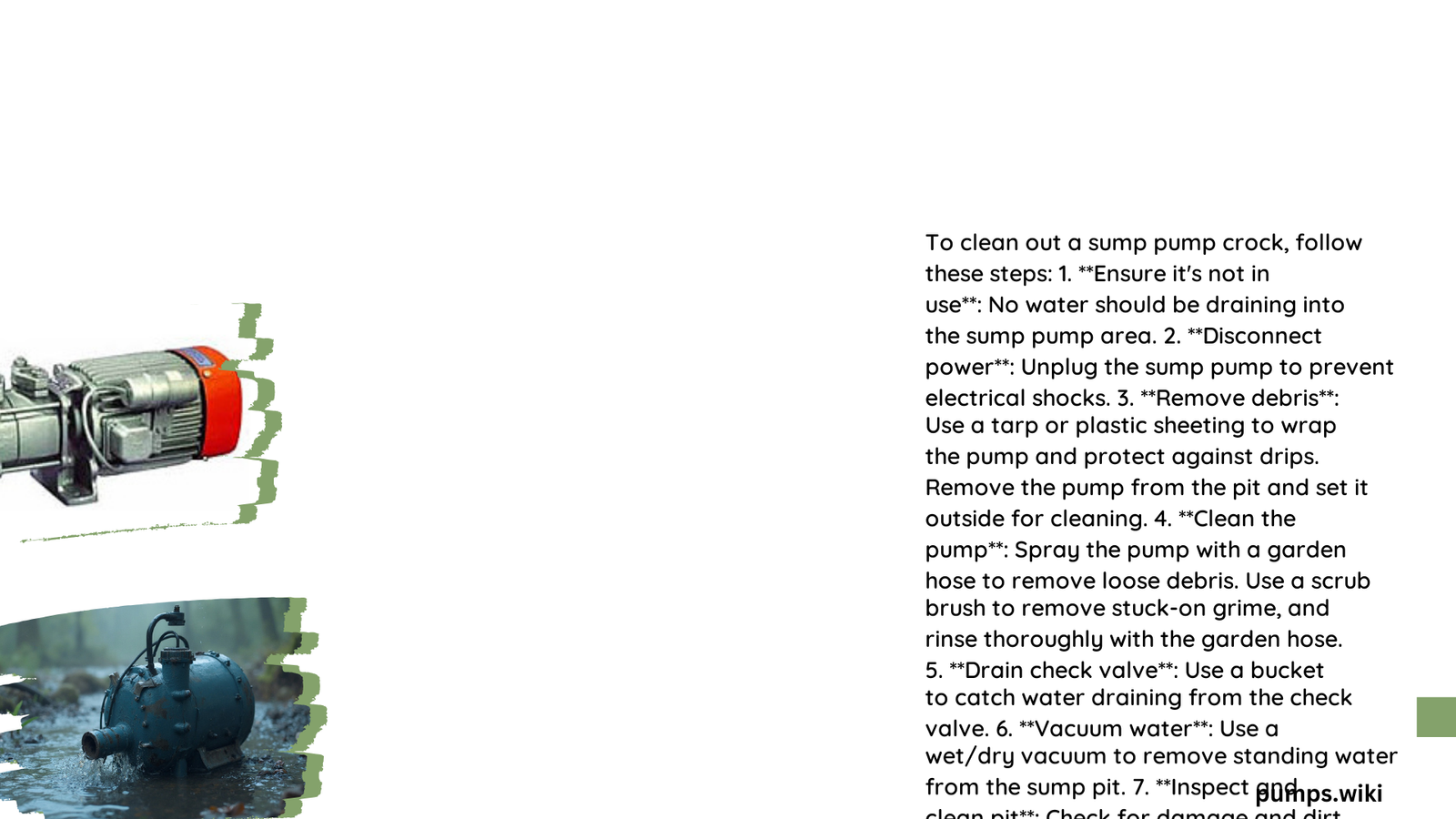Cleaning out a sump pump crock is essential for maintaining proper drainage and preventing basement flooding. This process involves removing debris, sediment, and potential contaminants from the sump pit and pump components. Regular cleaning ensures optimal pump performance, extends equipment lifespan, and safeguards your home against water damage. This guide provides step-by-step instructions for effectively cleaning your sump pump crock.
What Are the Safety Precautions for Cleaning a Sump Pump Crock?
Before beginning the cleaning process, it’s crucial to prioritize safety:
- Disconnect power to the sump pump by unplugging it or turning off the circuit breaker.
- Wear protective gear, including rubber gloves and safety goggles.
- Ensure adequate ventilation to prevent exposure to harmful fumes.
- Use caution when handling potentially contaminated water or debris.
What Tools Are Needed for Cleaning a Sump Pump Crock?

Gather the following tools before starting:
- Rubber gloves
- Safety goggles
- Screwdriver set
- Bucket
- Garden hose
- Plastic scraper or putty knife
- Wet/dry vacuum
- Tarps or plastic sheeting
- Mild dish soap or white vinegar
- Wire brush or old toothbrush
How to Clean a Sump Pump Crock Step-by-Step?
Follow these steps to thoroughly clean your sump pump crock:
- Disconnect and Remove the Pump
- Unplug the pump and disconnect discharge hoses
-
Carefully lift the pump out of the sump pit
-
Clean the Pump Exterior
- Wipe off dirt and debris with a damp cloth
-
Inspect for visible damage or corrosion
-
Clean the Sump Pit
- Remove sediment and debris from the pit bottom
- Check for cracks or damage in the pit walls
-
Clean the interior walls thoroughly
-
Clean Pump Components
- Thoroughly clean the intake screen
- Inspect and clean the impeller
- Clean the pump housing interior
-
Ensure the float switch moves freely
-
Remove Debris and Mold
- Use a scraper or putty knife to remove accumulations
-
Disinfect the pump and basin
-
Rinse and Reassemble
- Rinse all components with a garden hose
- Reattach hoses and place the pump back in the pit
- Reconnect power and test the pump
How Long Does It Take to Clean a Sump Pump Crock?
The cleaning process typically takes 1-2 hours, depending on the level of cleaning required. Here’s a breakdown of estimated times for each step:
| Step | Estimated Time |
|---|---|
| Disconnecting and removing the pump | 10-15 minutes |
| Cleaning the exterior | 10-15 minutes |
| Cleaning the sump pit | 15-30 minutes |
| Cleaning pump components | 20-30 minutes |
| Removing debris and mold | 20-30 minutes |
| Rinsing and reassembling | 15-30 minutes |
How Often Should a Sump Pump Crock Be Cleaned?
Sump pump crocks should be cleaned at least once a year. However, more frequent cleaning may be necessary in areas prone to heavy groundwater or flooding. Regular inspections can help determine if more frequent cleaning is needed.
What Are the Signs That a Sump Pump Crock Needs Cleaning?
Look out for these indicators that your sump pump crock requires cleaning:
- Visible debris or sediment in the sump pit
- Corrosion or rust on the pump casing
- Mold or algae buildup
- Reduced pump efficiency
- Failure to activate properly
- Signs of damage or cracks in the sump pit or pump
What Types of Debris Are Commonly Found in Sump Pump Crocks?
Sump pump crocks often accumulate various types of debris, including:
- Dirt and soil
- Sediment
- Mold and algae
- Small rocks or pebbles
- Organic matter (leaves, twigs, etc.)
- Mineral deposits
What Are the Best Methods for Removing Debris from a Sump Pump Crock?
To effectively remove debris from your sump pump crock:
- Use a plastic scraper or putty knife for stubborn accumulations
- Clean the intake screen with a soft brush and soapy water
- Inspect and clean the impeller to ensure free rotation
- Flush out loosened debris with a garden hose
- Use a wet/dry vacuum for removing standing water and fine debris
How to Address Specific Challenges When Cleaning a Sump Pump Crock?
When cleaning your sump pump crock, you may encounter these challenges:
- Mold growth: Use a mixture of warm water and vinegar (2:1 ratio) to dissolve and clean mold.
- Corrosion: Inspect for rust and consider replacing severely corroded parts.
- Stuck components: Apply a lubricant like WD-40 to free trapped pieces.
- Float switch issues: Ensure the switch moves freely to avoid activation problems.
By following these guidelines and regularly maintaining your sump pump crock, you can ensure optimal performance and protect your home from potential water damage.
References:
1. Ajalberts – Cleaning A Sump Pump Is Easy With These 6 Steps
2. WP Plumbing – How To Clean Your Sump Pump
3. Robinson Plumbing – How To Clean Your Sump Pump Properly
